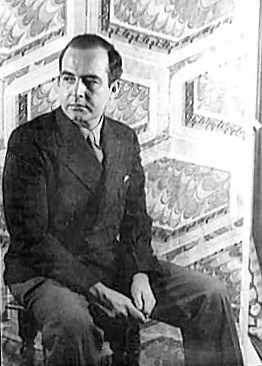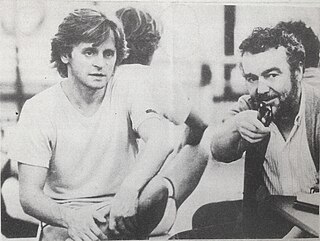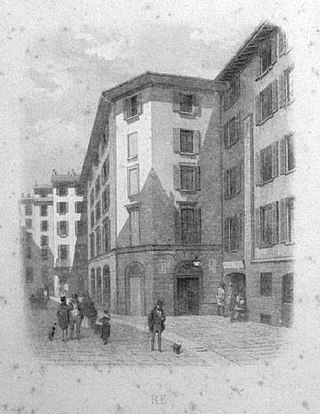
Spoleto is an ancient city in the Italian province of Perugia in east-central Umbria on a foothill of the Apennines. It is 20 km (12 mi) S. of Trevi, 29 km (18 mi) N. of Terni, 63 km (39 mi) SE of Perugia; 212 km (132 mi) SE of Florence; and 126 km (78 mi) N of Rome.

The Teatro Comunale di Bologna is an opera house in Bologna, Italy. Typically, it presents eight operas with six performances during its November to April season.

Teatro Regio di Parma, originally constructed as the Nuovo Teatro Ducale, is an opera house and opera company in Parma, Italy.

A Hand of Bridge, opus 35, is an opera in one act composed by Samuel Barber with libretto by Gian Carlo Menotti, and is possibly the shortest opera that is regularly performed: it lasts about nine minutes. It premiered as a part of Menotti's Festival of Two Worlds in Spoleto on 17 June 1959 at the Teatro Caio Melisso. The United States premiere occurred the next year. The opera consists of two unhappily married couples playing a hand of bridge, during which each character has an arietta in which he or she professes his or her inner desires.

The Consul is an opera in three acts with music and libretto by Gian Carlo Menotti, his first full-length opera.

The Teatro dell'Opera di Roma is an opera house in Rome, Italy. Originally opened in November 1880 as the 2,212 seat Costanzi Theatre, it has undergone several changes of name as well modifications and improvements. The present house seats 1,600.

The Festival dei Due Mondi(Festival of the Two Worlds) is an annual summer music and opera festival held each June to early July in Spoleto, Italy, since its founding by composer Gian Carlo Menotti in 1958. It features a vast array of concerts, opera, dance, drama, visual arts and roundtable discussions on science.

The Teatro Lirico Giuseppe Verdi is an opera house located in Trieste, Italy and named after the composer Giuseppe Verdi. Privately constructed, it was inaugurated as the Teatro Nuovo to replace the smaller 800-seat "Cesareo Regio Teatro di San Pietro" on 21 April 1801 with a performance of Johann Simon Mayr's Ginevra di Scozia. Initially, the Nuovo had 1,400 seats. In 1821, it became known as the Teatro Grande.

Lorenzo "Renzo" Mongiardino was an Italian architect, interior designer and production designer. He was nominated for two Academy Awards in the category Best Art Direction.

Oscar Strasnoy is a French-Argentine composer, conductor and pianist. Although primarily known for his stage works, the first of which Midea (2) premiered in Spoleto in 2000, his principal compositions also include two secular cantatas and several song cycles.
Le Testament de Villon is an opera composed in 1923 by the American poet Ezra Pound, with assistance from George Antheil. It is based on Le Testament, a collection of poems written by François Villon in 1461.

Teatro Rossini is the name of an opera house in Pesaro, Italy that serves as a venue for the Rossini Opera Festival.
Spiros Argiris was an orchestral and operatic conductor.

The Teatro Lirico Sperimentale di Spoleto was founded in 1947 by Adriano Belli, lawyer and musicologist, with the aim of helping young singers to start a career in opera, above all students who had already completed their singing studies and were gifted with artistic qualities, but had not yet made their artistic debut. The organization's offices are located in Spoleto, Italy.

PierLuigi Samaritani was a renowned opera director/production designer, who began his career at a young age, working alongside some of the greatest names in theatre, opera and ballet, such as Lila de Nobili, Giancarlo Menotti, Franco Zeffirelli, Luciano Pavarotti, Mikhail Baryshnikov, Rudolf Nureyev and many more. Samaritani had an enormous talent, which allowed him to take on all the roles the theatre, opera and ballet demanded, making sure to always be involved in all aspects of his productions even when delegating. From the creation of his "sketches" of the set, which were more like works of art in and of themselves to the smallest change in an extra’s costume, he was a true perfectionist preoccupied with every detail. His productions graced the stage of countless opera houses and theaters, amongst them La Scala di Milano, Teatro Regio of Parma, The Metropolitan Opera House, American Ballet Theatre and the Festival of Two Worlds at Spoleto, where he collaborated for many years, alongside his dear friend, Gian Carlo Menotti. The Teatro Lirico Sperimentale di Spoleto founded in 1947 in Spoleto, by Adriano Belli created a special award carrying the name of Pier Luigi Samaritani, awarded each year to the set designer with the best set design of the opera season.

Gian Carlo Menotti was an Italian composer, librettist, director, and playwright who is primarily known for his output of 25 operas. Although he often referred to himself as an American composer, he kept his Italian citizenship. One of the most frequently performed opera composers of the 20th century, his most successful works were written in the 1940s and 1950s. Highly influenced by Giacomo Puccini and Modest Mussorgsky, Menotti further developed the verismo tradition of opera in the post-World War II era. Rejecting atonality and the aesthetic of the Second Viennese School, Menotti's music is characterized by expressive lyricism which carefully sets language to natural rhythms in ways that highlight textual meaning and underscore dramatic intent.

The Teatro Nuovo is a theatre located on Via Montecalvario in the Quartieri Spagnoli district of Naples. The original theatre was an opera house designed by Domenico Antonio Vaccaro. Completed in 1724, it was also known as the Teatro Nuovo sopra Toledo and the Teatro Nuovo de Montecalvario. The theatre specialised in the opera buffa genre and saw the world premieres of hundreds of operas in its heyday. These included fifteen of Cimarosa's operas and seven of Donizetti's. The present theatre is the third to have been erected on the site following its destruction by fire in 1861 and again in 1935.
Teatro Nuovo can refer to the American opera company Teatro Nuovo or to any of the following theatres in Italy:
Napoli milionaria is an opera in three acts composed by Nino Rota to an Italian libretto by Eduardo De Filippo based on his 1945 play of the same name that was also made into the 1950 play Side Street Story. Conducted by Bruno Bartoletti, the opera premiered at the Teatro Caio Melisso in Spoleto on 22 June 1977 as part of the Festival dei Due Mondi.

The Teatro Re was a theatre in Milan, located near the Piazza del Duomo and named for its proprietor, Carlo Re. It functioned as both a prose theatre and an opera house and saw the world premieres of numerous operas, including four by Giovanni Pacini. Designed by Luigi Canonica, the theatre was inaugurated in 1813, closed in 1872, and demolished in 1879.
















